Current and Potential Future Seasonal Trends of Indoor Dwelling Temperature and Likely Health Risks in Rural Southern Africa
Abstract
1. Introduction
2. Materials and Methods
2.1. Study Area
2.2. Outdoor Weather Data
2.3. Indoor Temperature and Relative Humidity Data
2.4. Apparent Temperature
- Ta = dry bulb temperature (°C)
- e = water vapour pressure (hPa)
- ws = wind speed (m/s) at an elevation of 10 m (set to 0 because this was an indoor setting)
2.5. Household Questionnaire
2.6. Data and Statistical Analyses
3. Results
3.1. Household Characteristics
3.2. Current Seasonal Trends in Indoor and Outdoor Temperatures
3.3. Current Likely Health Risks Based on AT Calculations of Indoor Temperatures
3.4. Potential Future Temperature and Associated Heat-Health Risks
4. Discussion
5. Conclusions
Author Contributions
Acknowledgments
Conflicts of Interest
References
- McGregor, G.R.; Bessemoulin, P.; Ebi, K.L.; Menne, B. (Eds.) Heatwaves and Health: Guidance on Warning-System Development; World Meteorological Organization: Geneva, Switzerland, 2015. [Google Scholar]
- Frontczak, M.; Wargocki, P. Literature survey on how different factors influence human comfort in indoor environments. Build. Environ. 2011, 46, 922–937. [Google Scholar] [CrossRef]
- Basu, R.; Ostro, B.D. A multicounty analysis identifying the populations vulnerable to mortality associated with high ambient temperature in California. Am. J. Epidemiol. 2008, 168, 632–637. [Google Scholar] [CrossRef] [PubMed]
- Kovats, R.S.; Hajat, S. Heat stress and public health: A critical review. Annu. Rev. Public Health 2008, 29, 41–55. [Google Scholar] [CrossRef] [PubMed]
- Saez, M.; Sunyer, J.; Castellsague, J.; Murillo, C.; Anto, J.M. Relationship between weather temperature and mortality: A time series analysis approach in Barcelona. Int. J. Epidemiol. 1995, 24, 576–582. [Google Scholar] [CrossRef] [PubMed]
- Centers for Disease Control and Prevention. Impact of heat waves on mortality—Rome, Italy, June-August 2003. MMWR Morb. Mortal. Wkly. Rep. 2004, 53, 369–371. [Google Scholar]
- Yang, J.; Ou, C.Q.; Ding, Y.; Zhou, Y.X.; Chen, P.Y. Daily temperature and mortality: A study of distributed lag non-linear effect and effect modification in Guangzhou. Environ. Health 2012, 11, 63. [Google Scholar] [CrossRef] [PubMed]
- Kruger, A.; Sekele, S. Trends in extreme temperature indices in South Africa: 1962–2009. Int. J. Climatol. 2013, 33, 661–676. [Google Scholar] [CrossRef]
- Smith, T.M.; Reynolds, R.W. A global merged land–air–sea surface temperature reconstruction based on historical observations (1880–1997). J. Clim. 2005, 18, 2021–2036. [Google Scholar] [CrossRef]
- Lugina, K.; Groisman, P.Y.; Vinnikov, K.Y.; Kocknaeva, V.V.; Speranskaya, N.A. Monthly Surface Air Temperature Time Series Area-Averaged over the 30-Degree Latitudinal Belts of the Globe; Carbon Dioxide Information Analysis Center (CDIAC), Oak Ridge National Laboratory, U.S. Department of Energy: Oak Ridge, TN, USA, 2006.
- Caesar, J.; Alexander, L.; Vose, R. Large-scale changes in observed daily maximum and minimum temperatures: Creation and analysis of a new gridded data set. J. Geophys. Res. Atmos. 2006, 111. [Google Scholar] [CrossRef]
- UNFCCC. UNFCCC. UNFCCC Conference of the Parties (COP). In Adoption of the Paris Agreement; FCCC/CP/2015/L.9/Rev.1; United Nations Office: Geneva, Switzerland, 2015. [Google Scholar]
- Patz, J.A.; Campbell-Lendrum, D.; Holloway, T.; Foley, J.A. Impact of regional climate change on human health. Nature 2005, 438, 310–317. [Google Scholar] [CrossRef] [PubMed]
- Vardoulakis, S.; Dear, K.; Hajat, S.; Heaviside, C.; Eggen, B.; McMichael, A.J. Comparative assessment of the effects of climate change on heat-and cold-related mortality in the United Kingdom and Australia. Environ. Health Perspect. 2014, 122, 1285–1292. [Google Scholar] [CrossRef] [PubMed]
- Russo, S.; Marchese, A.F.; Sillmann, J.; Immé, G. When will unusual heat waves become normal in a warming Africa? Environ. Res. Lett. 2016, 11, 054016. [Google Scholar] [CrossRef]
- Clark, R.T.; Brown, S.J.; Murphy, J.M. Modeling northern hemisphere summer heat extreme changes and their uncertainties using a physics ensemble of climate sensitivity experiments. J. Clim. 2006, 19, 4418–4435. [Google Scholar] [CrossRef]
- Fischer, E.M.; Beyerle, U.; Knutti, R. Robust spatially aggregated projections of climate extremes. Nat. Clim. Chang. 2013, 3, 1033. [Google Scholar] [CrossRef]
- Engelbrecht, F.; Adegoke, J.; Bopape, M.J.; Naidoo, M.; Garland, R.; Thatcher, M.; McGregor, J.; Katzfey, J.; Werner, M.; Ichoku, C.; et al. Projections of rapidly rising surface temperatures over Africa under low mitigation. Environ. Res. Lett. 2015, 10, 085004. [Google Scholar] [CrossRef]
- Blum, L.N.; Bresolin, L.B.; Williams, M.A. Heat-related illness during extreme weather emergencies. JAMA 1998, 279, 1514–1514. [Google Scholar] [PubMed]
- Jardine, D.S. Heat illness and heat stroke. Pediatr. Rev. 2007, 28, 249. [Google Scholar] [CrossRef] [PubMed]
- Centers for Disease Control and Prevention. Heat-related deaths—Dallas, Wichita, and Cooke counties, Texas, and United States, 1996. MMWR Morb. Mortal. Wkly. Rep. 1997, 46, 528–531. [Google Scholar]
- Bai, L.; Li, Q.; Wang, J.; Lavigne, E.; Gasparrini, A.; Copes, R.; Yagouti, A.; Burnett, R.T.; Goldberg, M.S.; Villeneuve, P.J.; et al. Hospitalizations from hypertensive diseases, diabetes, and arrhythmia in relation to low and high temperatures: Population-based study. Sci. Rep. 2016, 6, 30283. [Google Scholar] [CrossRef] [PubMed]
- Lin, S.; Luo, M.; Walker, R.J.; Liu, X.; Hwang, S.A.; Chinery, R. Extreme High Temperatures and Hospital Admissions for Respiratory and Cardiovascular Diseases. Epidemiology 2009, 20, 738–746. [Google Scholar] [CrossRef] [PubMed]
- Díaz, J.; Linares, C.; Tobías, A. A critical comment on heat wave response plans. Eur. J. Public Health 2006, 16, 600. [Google Scholar] [CrossRef] [PubMed]
- Tong, S.; Wang, X.Y.; Barnett, A.G. Assessment of heat-related health impacts in Brisbane, Australia: Comparison of different heatwave definitions. PLoS ONE 2010, 5, e12155. [Google Scholar] [CrossRef] [PubMed]
- Basu, R.; Samet, J.M. Relation between elevated ambient temperature and mortality: A review of the epidemiologic evidence. Epidemiol. Rev. 2002, 24, 190–202. [Google Scholar] [CrossRef] [PubMed]
- IPCC. Intergovernmental Panel on Climate Change (IPCC)—Working Group II: Impacts, Adaptation and Vulnerability. Available online: http://www.ipcc.ch/ipccreports/tar/wg2/index.php?idp=353 (accessed on 9 October 2017).
- Azongo, D.K.; Awine, T.; Wak, G.; Binka, F.N.; Rexford Oduro, A. A time series analysis of weather variables and all-cause mortality in the Kasena-Nankana Districts of Northern Ghana, 1995–2010. Glob. Health Action 2012, 5, 19073. [Google Scholar] [CrossRef] [PubMed]
- Diboulo, E.; Sie, A.; Rocklöv, J.; Niamba, L.; Ye, M.; Bagagnan, C.; Sauerborn, R. Weather and mortality: A 10 year retrospective analysis of the Nouna Health and Demographic Surveillance System, Burkina Faso. Glob. Health Action 2012, 5, 19078. [Google Scholar] [CrossRef] [PubMed]
- Egondi, T.; Kyobutungi, C.; Kovats, S.; Muindi, K.; Ettarh, R.; Rocklöv, J. Time-series analysis of weather and mortality patterns in Nairobi’s informal settlements. Glob. Health Action 2012, 5, 19065. [Google Scholar] [CrossRef] [PubMed]
- McMichael, A.J.; Wilkinson, P.; Kovats, R.S.; Pattenden, S.; Hajat, S.; Armstrong, B.; Vajanapoom, N.; Niciu, E.M.; Mahomed, H.; Kingkeow, C.; et al. International study of temperature, heat and urban mortality: The ‘ISOTHURM’ project. Int. J. Epidemiol. 2008, 37, 1121–1131. [Google Scholar] [CrossRef] [PubMed]
- Scovronick, N.; Sera, F.; Acquaotta, F.; Garzena, D.; Fratianni, S.; Wright, C.Y.; Gasparrini, A. The association between ambient temperature and mortality in South Africa: A time-series analysis. Environ. Res. 2018, 161, 229–235. [Google Scholar] [CrossRef] [PubMed]
- Mathee, A.; Oba, J.; Rose, A. Climate change impacts on working people (the HOTHAPS initiative): Findings of the South. African pilot study. Glob. Health Action 2010, 3, 5612. [Google Scholar] [CrossRef] [PubMed]
- Wright, C.; Coetzee, G.; Ncongwane, K. Seasonal trends in potential sunburn risk among outdoor workers in South. Africa using monitored ambient solar UV radiation levels. Occup. Health S. Afr. 2011, 17, 22–29. [Google Scholar]
- McGregor, G.R.; Felling, M.; Wolf, T.; Gosling, S. The social impacts of heat waves. In The Social Impacts of Heat Waves; Environment Agency: Bristol, UK, 2007. [Google Scholar]
- Van Vuuren, D.P.; Edmonds, J.; Kainuma, M.; Riahi, K.; Thomson, A.; Hibbard, K.; Hurtt, G.C.; Kram, T.; Krey, V.; Lamarque, J.F.; et al. The representative concentration pathways: An overview. Clim. Chang. 2011, 109, 5. [Google Scholar] [CrossRef]
- Moss, R.; Babiker, W.; Brinkman, S.; Calvo, E.; Carter, T.; Edmonds, J.; Elgizouli, I.; Emori, S.; Erda, L.; Hibbard, K.; et al. Towards New Scenarios for the Analysis of Emissions: Climate Change, Impacts and Response Strategies; Intergovernmental Panel on Climate Change Secretariat (IPCC): Geneva, Switzerland, 2008. [Google Scholar]
- Symon, C. Climate Change: Actions, Trends and Implications for Business; The IPCC Fifth Assessment Report, Working Group 1; Cambridge University Press: Cambridge, UK, 2013. [Google Scholar]
- Stats, S.A. Library Cataloguing-in-Publication (CIP) Data; 2011 Statistical Release; Statistics South Africa Census: Pretoria, South Africa, 2011.
- Statstistics South Africa Living Conditions Survey: 2014/2015. Available online: http://www.statssa.gov.za/publications/P0310/P03102014.pdf (accessed on 22 September 2017).
- Cook, C.; Reason, C.J.; Hewitson, B.C. Wet and dry spells within particularly wet and dry summers in the South African summer rainfall region. Clim. Res. 2004, 26, 17–31. [Google Scholar] [CrossRef]
- Levey, K.M.; Jury, M.R. Composite intraseasonal oscillations of convection over Southern Africa. J. Clim. 1996, 9, 1910–1920. [Google Scholar] [CrossRef]
- Tennant, W.J.; Hewitson, B.C. Intra-seasonal rainfall characteristics and their importance to the seasonal prediction problem. Int. J. Climatol. 2002, 22, 1033–1048. [Google Scholar] [CrossRef]
- Kruger, A.C.; Shongwe, S. Temperature trends in South Africa: 1960–2003. Int. J. Climatol. 2004, 24, 1929–1945. [Google Scholar] [CrossRef]
- Mahlobo, D.; Kruger, A.; Funde, S.; Phakula, S. Climate Services & SAWS. 2013. Available online: http://www.wmo.int/pages/prog/wcp/wcdmp/documents/SouthAfrica.pdf (accessed on 14 March 2018).
- Garland, R.M.; Matooane, M.; Engelbrecht, F.A.; Bopape, M.J.M.; Landman, W.A.; Naidoo, M.; Merwe, J.V.D.; Wright, C.Y. Regional projections of extreme apparent temperature days in Africa and the related potential risk to human health. Int. J. Environ. Res. Public Health 2015, 12, 12577–12604. [Google Scholar] [CrossRef] [PubMed]
- Harlan, S.L.; Brazel, A.J.; Prashad, L.; Stefanov, W.L.; Larsen, L. Neighborhood microclimates and vulnerability to heat stress. Soc. Sci. Med. 2006, 63, 2847–2863. [Google Scholar] [CrossRef] [PubMed]
- Watts, J.D.; Kalkstein, L.S. The development of a warm-weather relative stress index for environmental applications. J. Appl. Meteorol. 2004, 43, 503–513. [Google Scholar] [CrossRef]
- Baccini, M.; Biggeri, A.; Accetta, G.; Kosatsky, T.; Katsouyanni, K.; Analitis, A.; Anderson, H.R.; Bisanti, L.; D’ippoliti, D.; Danova, J.; et al. Heat effects on mortality in 15 European cities. Epidemiology 2008, 19, 711–719. [Google Scholar] [CrossRef] [PubMed]
- Steadman, R.G. Norms of apparent temperature in Australia. Aust. Meteorol. Mag. 1994, 43, 1–16. [Google Scholar]
- NOAA. Available online: http://www.nws.noaa.gov/om/heat/heat_index.shtml (accessed on 12 July 2017).
- Stata Corp. Statistical Software: Release 14.0; Stata Corporation: College Station, TX, USA, 2001. [Google Scholar]
- The World Bank Climate Change Knowledge Portal for. Development Practitioners and Policy Makers. Available online: http://sdwebx.worldbank.org/climateportal/index.cfm?page=country_future_climate&ThisRegion=Africa&ThisCcode=ZAF (accessed on 16 November 2017).
- Riahi, K.; Grübler, A.; Nakicenovic, N. Scenarios of long-term socio-economic and environmental development under climate stabilization. Technol. Forecast. Soc. Chang. 2007, 74, 887–935. [Google Scholar] [CrossRef]
- Metadata of the Climate Change Knowledge Portal. Available online: http://sdwebx.worldbank.org/climateportal/doc/Metadata_2017.pdf (accessed on 20 April 2018).
- SAWS. Available online: http://www.weathersa.co.za/learning/weather-questions/82-how-are-the-dates-of-the-four-seasons-worked-out (accessed on 12 July 2017).
- Nitschke, M.; Tucker, G.R.; Hansen, A.L.; Williams, S.; Zhang, Y.; Bi, P. Impact of two recent extreme heat episodes on morbidity and mortality in Adelaide, South Australia: A case-series analysis. Environ. Health 2011, 10, 42. [Google Scholar] [CrossRef] [PubMed]
- Bai, L.; Ding, G.; Gu, S.; Bi, P.; Su, B.; Qin, D.; Xu, G.; Liu, Q. The effects of summer temperature and heat waves on heat-related illness in a coastal city of China, 2011–2013. Environ. Res. 2014, 132, 212–219. [Google Scholar] [CrossRef] [PubMed]
- Kim, Y.; Joh, S. A vulnerability study of the low-income elderly in the context of high temperature and mortality in Seoul, Korea. Sci. Total Environ. 2006, 371, 82–88. [Google Scholar] [CrossRef] [PubMed]
- Curriero, F.C.; Heiner, K.S.; Samet, J.M.; Zeger, S.L.; Strug, L.; Patz, J.A. Temperature and mortality in 11 cities of the Eastern United States. Am. J. Epidemiol. 2002, 155, 80–87. [Google Scholar] [CrossRef] [PubMed]
- Bidassey-Manilal, S.; Wright, C.Y.; Engelbrecht, J.C.; Albers, P.N.; Garland, R.M.; Matooane, M. Students’ perceived heat-health symptoms increased with warmer classroom temperatures. Int. J. Environ. Res. Public Health 2016, 13, 566. [Google Scholar] [CrossRef] [PubMed]
- Smargiassi, A.; Fournier, M.; Griot, C.; Baudouin, Y.; Kosatsky, T. Prediction of the indoor temperatures of an urban area with an in-time regression mapping approach. J. Expo. Sci. Environ. Epidemiol. 2008, 18, 282. [Google Scholar] [CrossRef] [PubMed]
- White-Newsome, J.L.; Sánchez, B.N.; Jolliet, O.; Zhang, Z.; Parker, E.A.; Dvonch, J.T.; O’Neill, M.S. Climate change and health: Indoor heat exposure in vulnerable populations. Environ. Res. 2012, 112, 20–27. [Google Scholar] [CrossRef] [PubMed]
- Long Term Adaptation Scenarios Research Programme (LTAS): Full Technical Report on Climate Trends and Scenarios for South Africa. Available online: https://www.environment.gov.za/sites/default/files/docs/climate_trends_scenarios.pdf (accessed on 18 March 2018).
- Almeida, S.P.; Casimiro, E.; Calheiros, J. Effects of apparent temperature on daily mortality in Lisbon and Oporto, Portugal. Environ. Health 2010, 9, 12. [Google Scholar] [CrossRef] [PubMed]
- A Snapshot of Projected Maximum and Minimum Temperature Changes: South Africa. Available online: http://www.weathersa.co.za/images/documents/384/155986%20South%20African%20Weather%20Service=Scientific%20Newsletters_Mailer.pdf (accessed on 18 March 2017).
- United States Environmental Protection Agency: Adapting to Heat. Available online: https://www.epa.gov/heat-islands/adapting-heat (accessed on 23 April 2018).
- Luber, G.; McGeehin, M. Climate change and extreme heat events. Am. J. Prev. Med. 2008, 35, 429–435. [Google Scholar] [CrossRef] [PubMed]
- Semenza, J.C.; Rubin, C.H.; Falter, K.H.; Selanikio, J.D.; Flanders, W.D.; Howe, H.L.; Wilhelm, J.L. Heat-related deaths during the July 1995 heat wave in Chicago. N. Engl. J. Med. 1996, 335, 84–90. [Google Scholar] [CrossRef] [PubMed]
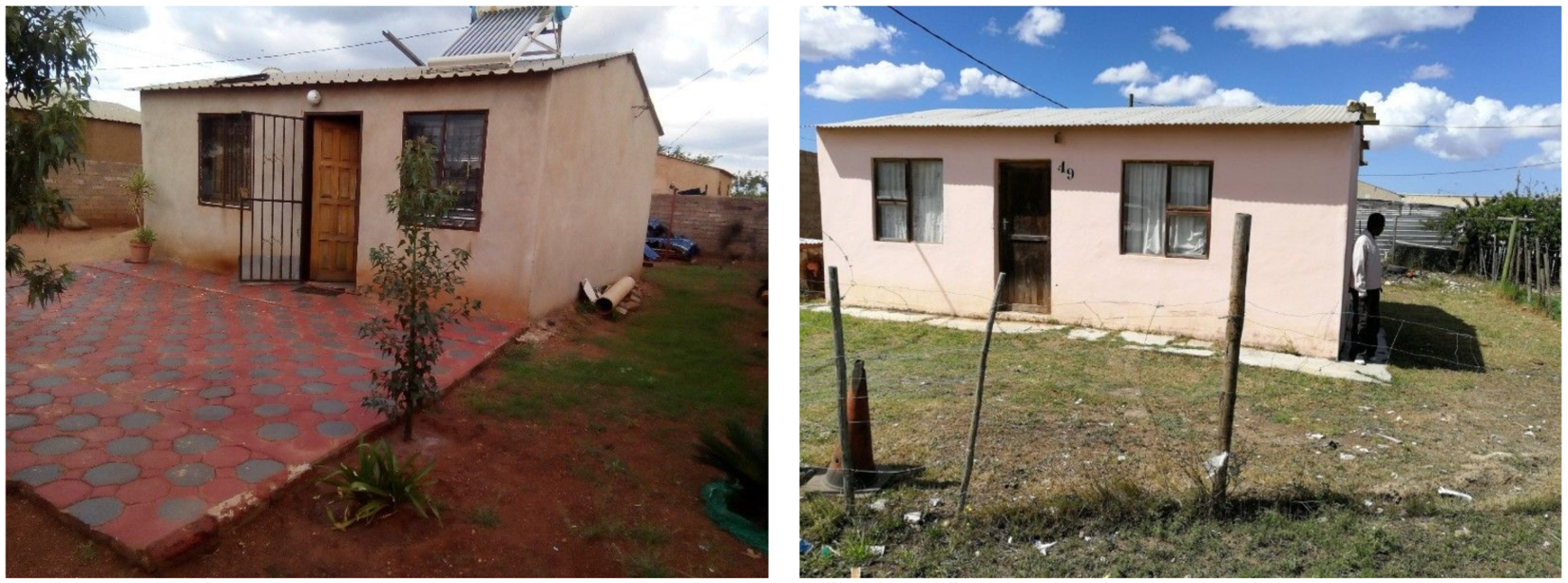
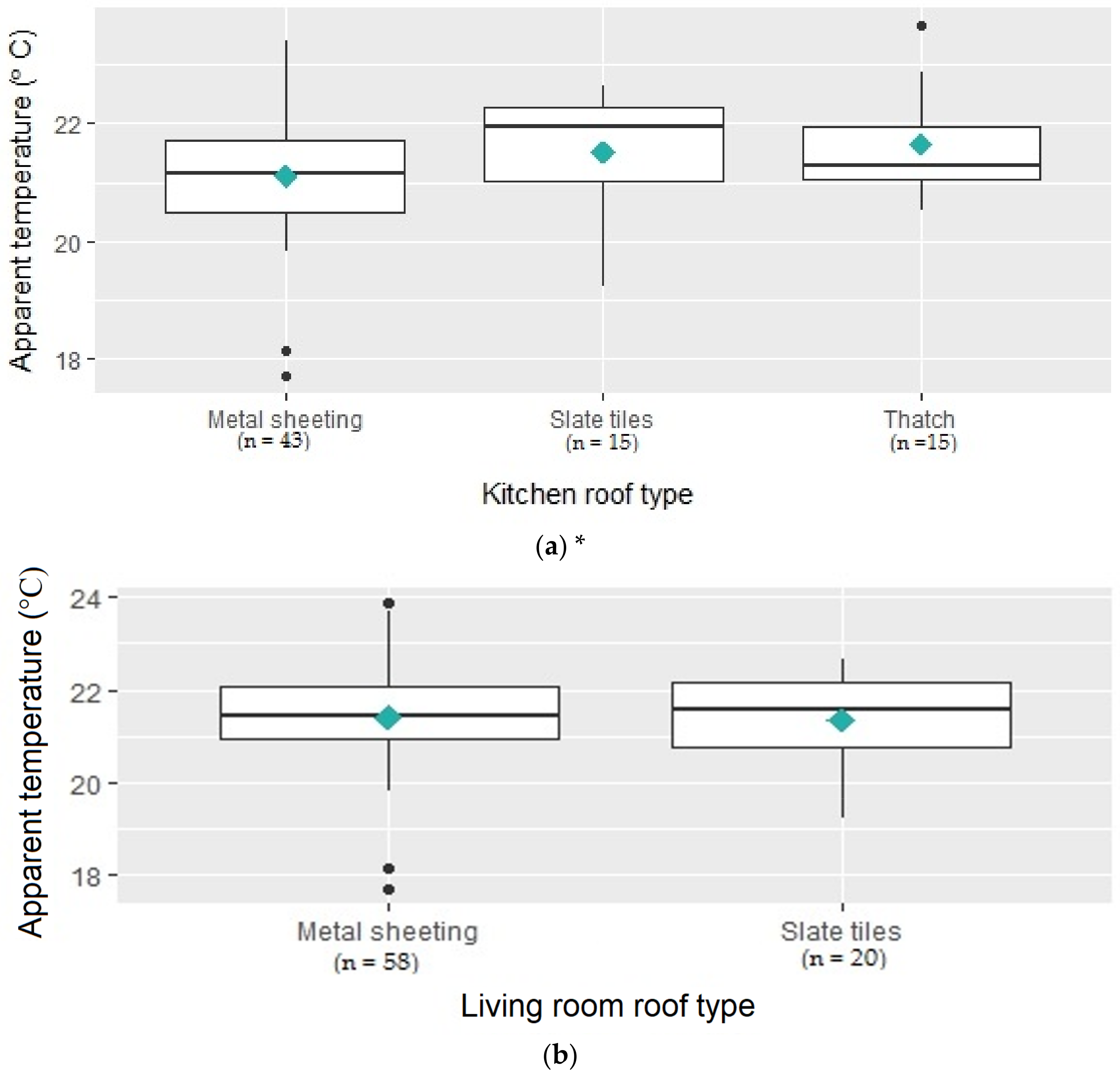
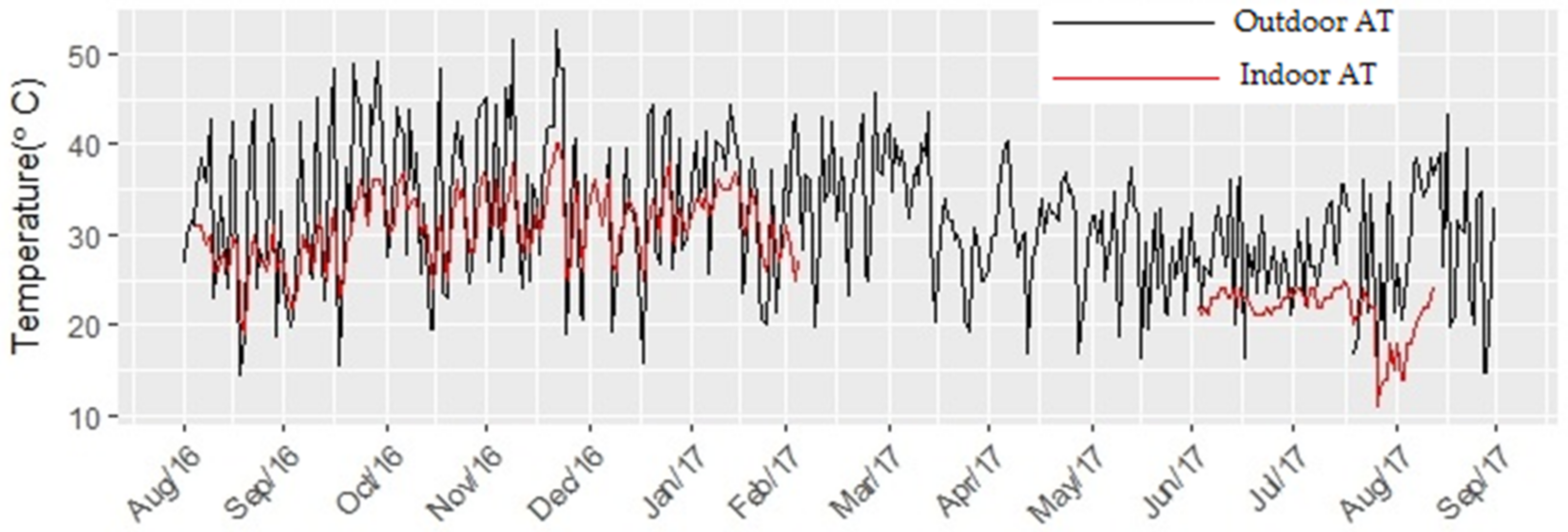
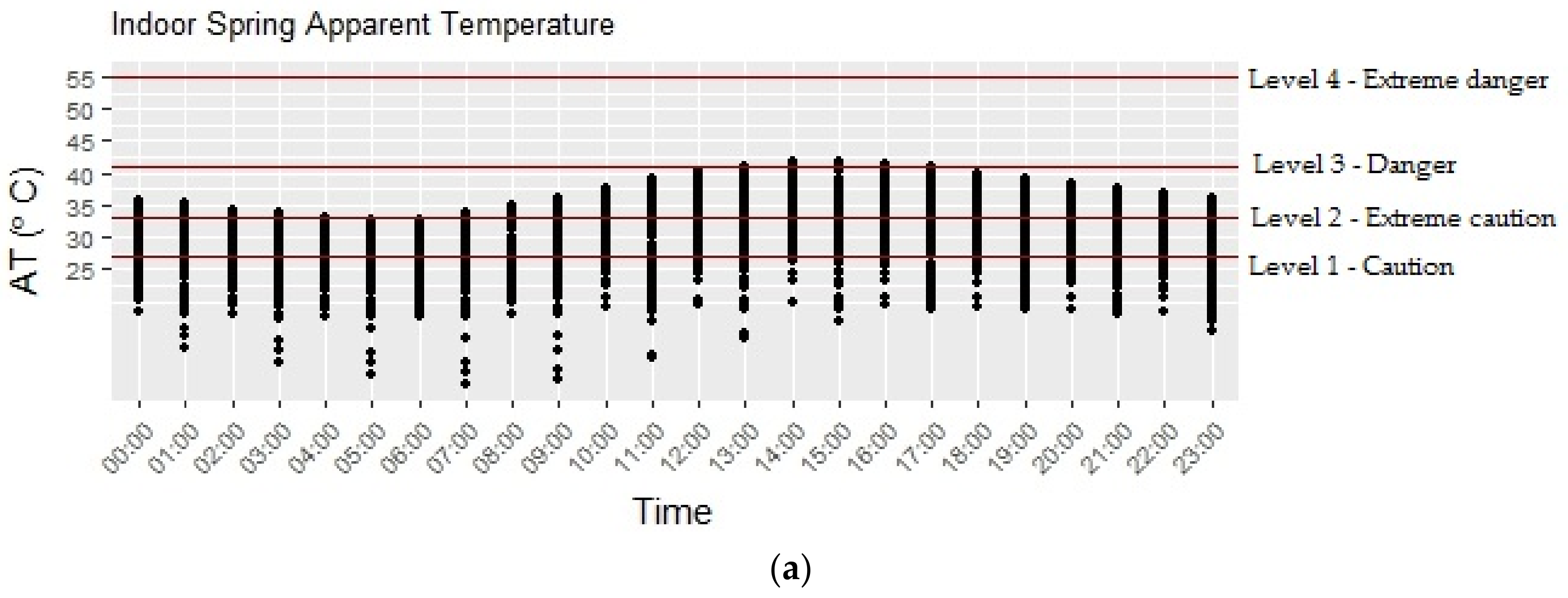
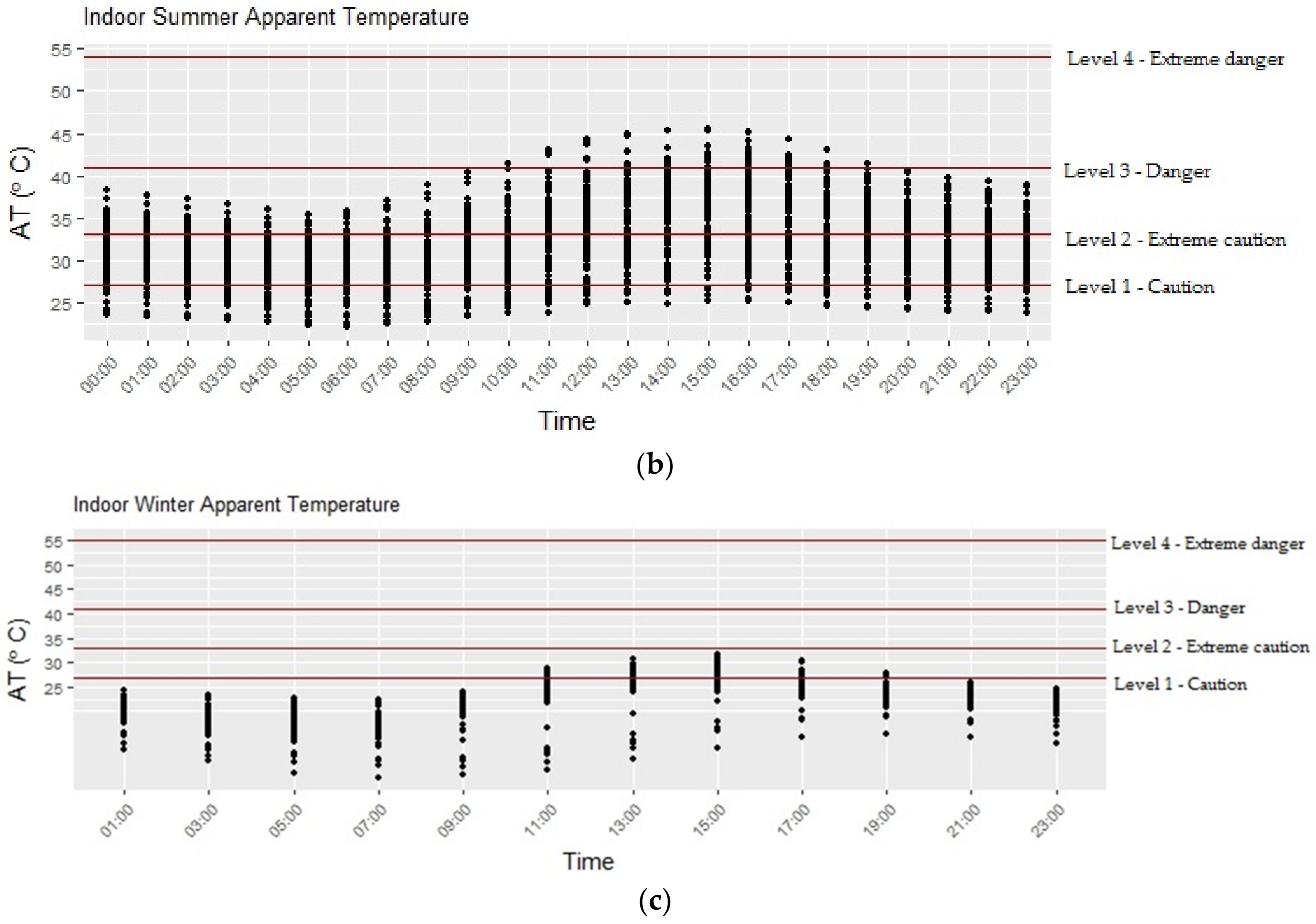

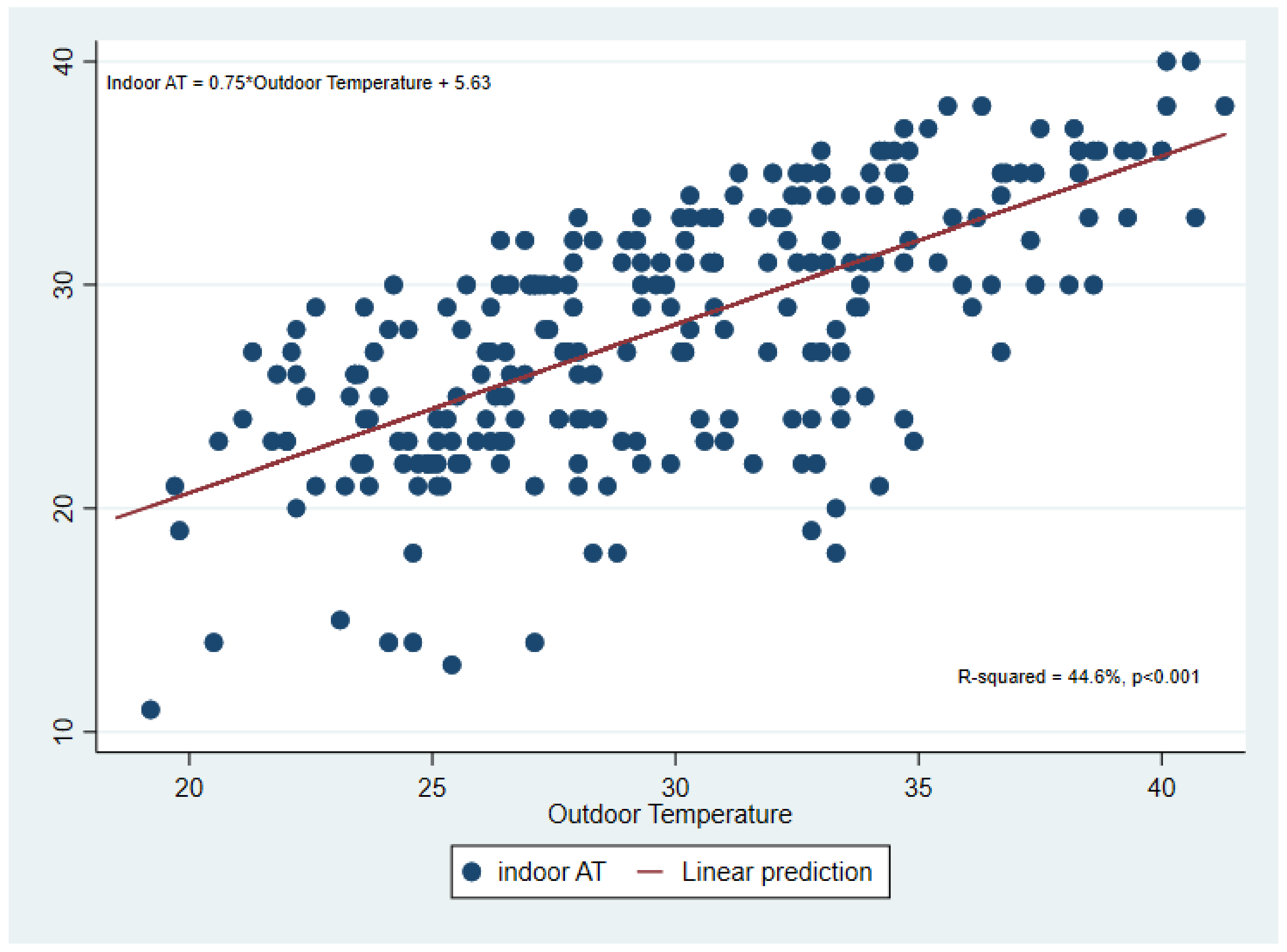
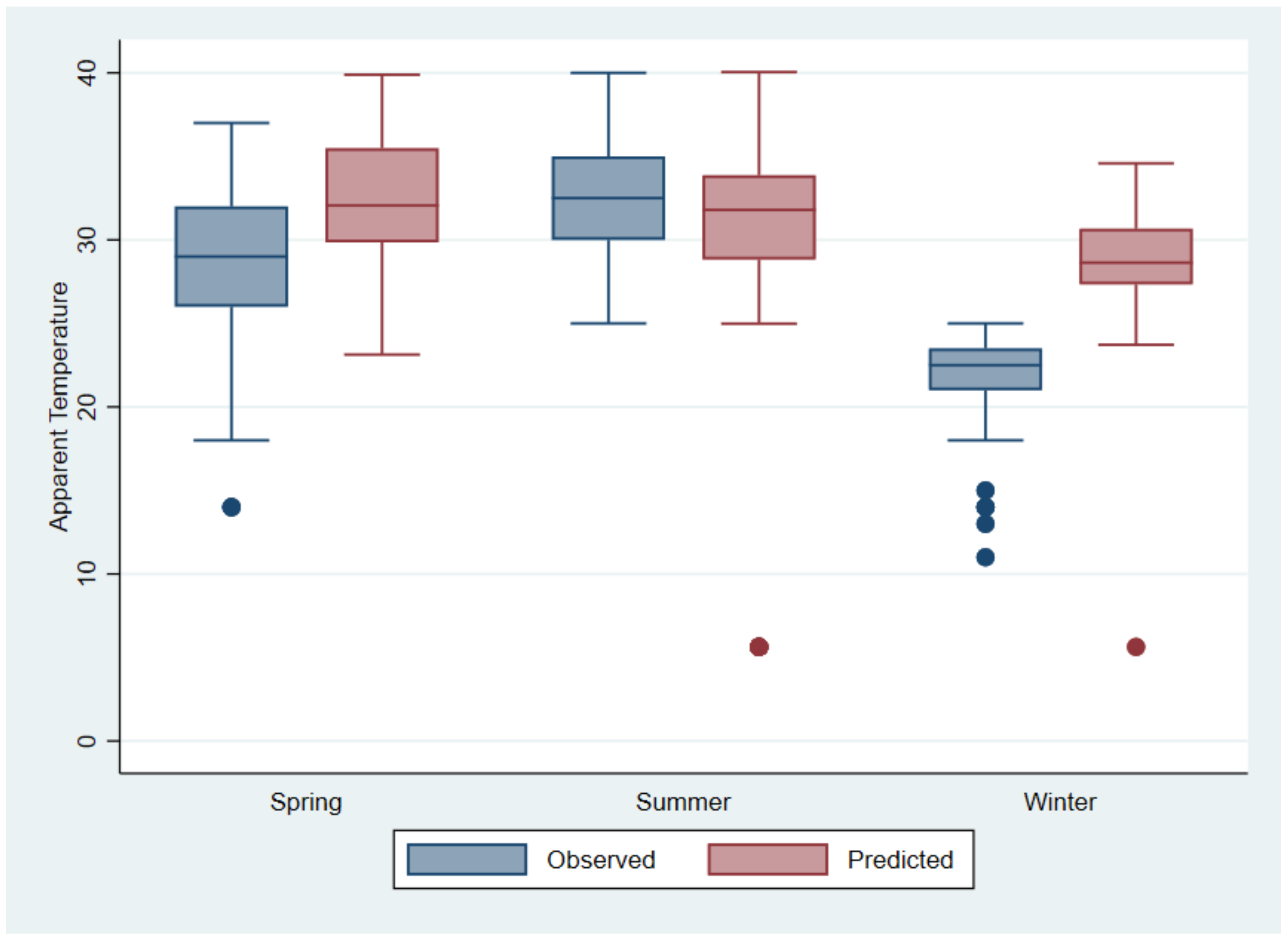
| Level | Apparent Temperature Range | Warning | Possible Heat Health Effect |
|---|---|---|---|
| 1 | 26.7–31.7 °C | Caution | Fatigue, discomfort possible |
| 2 | 32.2–40 °C | Extreme caution | Sunstroke, heat cramps, heat exhaustion possible |
| 3 | 40.6–53.9 °C | Danger | Sunstroke, heat cramps, heat exhaustion likely, heat stroke possible |
| 4 | 54.5 °C or higher | Extreme danger | Sunstroke and heat stroke highly likely |
| Variables | n | % |
|---|---|---|
| Number of people in household | ||
| <5 | 195 | 48.03 |
| 5–7 | 162 | 39.90 |
| 8–10 | 45 | 11.08 |
| >10 | 4 | 0.99 |
| Total | 406 | 100.00 |
| Number of children <5 years in household | ||
| 0 | 237 | 58.37 |
| 1 | 128 | 31.53 |
| 2 | 39 | 9.61 |
| 3 | 2 | 0.49 |
| Total | 406 | 100.00 |
| Average monthly income of household—excluding grants and pensions | ||
| No income | 121 | 29.66 |
| ZAR ≤ 1000 | 96 | 24.02 |
| ZAR1001–ZAR5000 | 100 | 24.51 |
| ≥ZAR > 5001 | 17 | 4.17 |
| Do not know | 72 | 17.65 |
| Total | 406 | 100.00 |
| * Number of people receiving the following grants | ||
| Old age pension | 142 | |
| Disability | 15 | |
| Child | 282 | |
| Other | 11 | |
| When the weather is warm, how does the house feel indoors? | ||
| Cooler than outside | 107 | 26.35 |
| Same as outside | 104 | 25.62 |
| Warmer than outside | 195 | 48.03 |
| Total | 406 | 100.00 |
| Do you use a fan during hot weather? | ||
| Yes | 159 | 39.16 |
| No | 247 | 60.84 |
| Total | 406 | 100.00 |
| Do you use an air conditioner during hot weather? | ||
| Yes | 17 | 4.19 |
| No | 389 | 95.81 |
| Total | 406 | 100.00 |
| Housing type | ||
| Formal house | 376 | 92.61 |
| Informal dwelling | 12 | 3.00 |
| Traditional dwelling | 16 | 3.90 |
| Backyard dwelling (formal) | 2 | 0.50 |
| Total | 406 | 100 |
| Season | Spring | Summer | Winter | |||
|---|---|---|---|---|---|---|
| Mean (SD) | Range | Mean (SD) | Range | Mean (SD) | Range | |
| Outdoor Temperature (°C) | 30.8 (5.3) | 18.5–40.7 | 30.3 (4.8) | 21.3–41.3 | 26.4 (3.1) | 19.2–33.4 |
| Outdoor AT (°C) | 32.5 (8.5) | 14.4–49.2 | 33.8 (8.4) | 15.7–52.8 | 27.5 (5.3) | 14.0–37.5 |
| Outdoor RH (%) | 78.4 (10.9) | 54.0–95.0 | 90.9 (6.1) | 70.0–96.0 | 85.3 (6.6) | 66.0–96.0 |
| Outdoor wind speed (m/s−1) | 8.7 (2.9) | 4.3–18.8 | 8.2 (3.0) | 2.9–15.1 | 6.7 (2.4) | 3.2–12.7 |
| Indoor Temperature (°C) | 27.2 (4.1) | 16.0–34.9 | 28.5 (3.0) | 22.8–35.6 | 22.1 (2.3) | 13.5–25.8 |
| Indoor AT (°C) | 28.4 (5.1) | 14.2–36.7 | 32.2 (3.4) | 24.6–40.0 | 21.8 (2.8) | 11.1–24.5 |
| Indoor RH (%) | 43.1 (9.1) | 25.6–66.9 | 60.7 (8.8) | 37.5–75.5 | 42.5 (8.4) | 22.7–60.3 |
| Variables | Coefficient | SE | p Value | 95% CI | |
|---|---|---|---|---|---|
| Dependent | Independent | ||||
| Indoor AT | Outdoor Temperature | 0.55 | 0.17 | 0.001 | 0.23–0.88 |
| Outdoor AT | 0.12 | 0.10 | 0.20 | −0.07–0.33 | |
| US NWS Classification | Apparent Temperature Range | Observed AT (Number of Days) | Predicted AT (Number of Days) | Possible Heat Health Effect |
|---|---|---|---|---|
| No risk | <26.7 °C | 97 | 23 | - |
| Caution | 26.7–31.7 °C | 78 | 107 | Fatigue, discomfort possible |
| Extreme caution | 32.2–40.0 °C | 61 | 106 | Sunstroke, heat cramps, heat exhaustion possible |
| Danger | 40.6–53.9 °C | 0 | 0 | Sunstroke, heat cramps, heat exhaustion likely, heat stroke possible |
| Extreme danger | 54.5 °C or higher | 0 | 0 | Sunstroke and heat stroke highly likely |
© 2018 by the authors. Licensee MDPI, Basel, Switzerland. This article is an open access article distributed under the terms and conditions of the Creative Commons Attribution (CC BY) license (http://creativecommons.org/licenses/by/4.0/).
Share and Cite
Kapwata, T.; Gebreslasie, M.T.; Mathee, A.; Wright, C.Y. Current and Potential Future Seasonal Trends of Indoor Dwelling Temperature and Likely Health Risks in Rural Southern Africa. Int. J. Environ. Res. Public Health 2018, 15, 952. https://doi.org/10.3390/ijerph15050952
Kapwata T, Gebreslasie MT, Mathee A, Wright CY. Current and Potential Future Seasonal Trends of Indoor Dwelling Temperature and Likely Health Risks in Rural Southern Africa. International Journal of Environmental Research and Public Health. 2018; 15(5):952. https://doi.org/10.3390/ijerph15050952
Chicago/Turabian StyleKapwata, Thandi, Michael T. Gebreslasie, Angela Mathee, and Caradee Yael Wright. 2018. "Current and Potential Future Seasonal Trends of Indoor Dwelling Temperature and Likely Health Risks in Rural Southern Africa" International Journal of Environmental Research and Public Health 15, no. 5: 952. https://doi.org/10.3390/ijerph15050952
APA StyleKapwata, T., Gebreslasie, M. T., Mathee, A., & Wright, C. Y. (2018). Current and Potential Future Seasonal Trends of Indoor Dwelling Temperature and Likely Health Risks in Rural Southern Africa. International Journal of Environmental Research and Public Health, 15(5), 952. https://doi.org/10.3390/ijerph15050952






